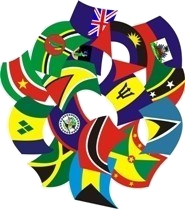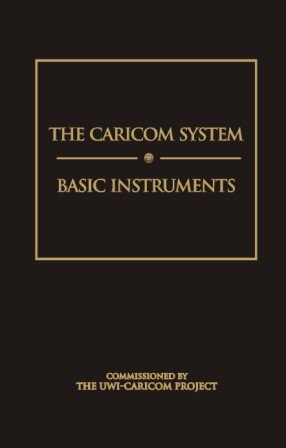The ‘CARICOM System’ is the term used to characterise the inter-governmental
organisations established by the political directorate of the Commonwealth Caribbean
countries by the Treaty of Chaguaramas 1973, and which maintain functional
relationships with the Caribbean Community designed to, or having the effect of,
facilitating the achievement of the objectives of the Caribbean Community. Although
the economic objectives of the Caribbean Community and Common Market established
by the original Treaty of Chaguaramas 1973, and the economic objectives of the
Caribbean Community, including the CARICOM Single Market and Economy (CSME)
established by the Revised Treaty of Chaguaramas 2001, are different in important
details, the broad objectives of both the founding and successor organisation are
essentially the same: economic integration, co-ordination of foreign policies and
functional co-operation.
1 The basic constituent instruments set out in this volume correspond to these three
policy areas. Although a few of the institutions predate the establishment of the
Caribbean Community, for example, the University of the West Indies and the Council
of Legal Education, their functions significantly complement the objectives of the
Caribbean Community.
A people without a history is incapable of identifying and evaluating their present
location in the vicissitudes of global development and vulnerable to mistakes in charting
a course for the future. The Caribbean Community is the measured institutional response
to historical and political developments as variegated as the under-seascape of the
Caribbean region. Much of that history has been recorded and interpreted outside by
persons outside of the Region whose evaluation of events has not always converged
with informed, dispassionate perceptions of a more indigenous breed of historians.
The collapse of the West Indian Federation in 1962 did not lead to the abortion of
regional initiatives in the area of functional co-operation. Functional co-operation among
the Commonwealth Caribbean territories not only continued after 1962, but intensified
in one or two areas, for example, in education. Thus, there was never any doubt that the
University of the West Indies would continue and that its courses would be enlarged to
accommodate the demands of an expanding post-secondary school population. Similarly,
attempts were made to produce lawyers of Caribbean vintage and to establish an
examination system relevant for the Region. These efforts eventuated in the establishment of the Council of Legal Education and the creation of the Caribbean Examinations Council. Coincident with initiatives in the area of functional co-operation
were efforts to salvage the West Indies Shipping Corporation and to see how the fragile
economies of Barbados and the OECS could survive in the post-1962 era. The
independence of Jamaica and Trinidad and Tobago in 1962 not only underscored the
vulnerability of the dependent Commonwealth Caribbean territories but also galvanised
efforts by the United Kingdom and Canada to establish a financial institution to mobilise
external capital for this group of political entities. These efforts bore fruit towards the
end of the decade. The only discordant note around this time emanated from British
Guiana which distanced itself, ideologically, from the Commonwealth Caribbean and
tried to emphasise its ‘differentness’ by setting up the University of Guyana.
Not unlike similar inter-governmental organisations in other parts of the globe,
the organisations and institutions comprising the CARICOM System either constituted
the measured response to regional or international developments or were established to
anticipate and influence such developments. However, irrespective of the original
motivation for the establishment of the organisations and institutions of the CARICOM
System, it is possible to discern in their structure and activities a measure of functional
coherence geared towards the consolidation and exploitation of synergies for the
achievement of collective goals. The University of the West Indies and the CARICOM
Secretariat recently concluded a co-operation agreement in order to pool resources for
the pursuit and achievement of regional goals.
Some of the CARICOM institutions have stood the test of times, surpassing the
most vaunting predictions of their ardent proponents. Others have under-performed
and become defunct. On balance, however, the successes seemed to have exceeded the
failures.
2. Central to the family of organisations and institutions of the CARICOM System is
the Caribbean Community including the CARICOM Single Market and Economy
(CSME) established by the Revised Treaty of Chaguaramas, 2001. At present, the
Caribbean Community is in an advanced stage of transition. Of the nine Protocols
which have been elaborated, only four have been signed and provisionally applied.
3. The Revised Treaty of Chaguaramas, which integrates and consolidates the nine
Protocols, has been signed by eight Heads of Government and has not been provisionally
applied. However, it is envisaged that this instrument will be signed and provisionally
applied as suggested by the Prime Ministerial Sub-Committee on the CSME which is
under the chairmanship of the Prime Minister of Barbados. The CARICOM Secretariat
has prepared a Protocol on Provisional Application of the Revised Treaty as well as a
Protocol on the Revised Treaty of Chaguaramas providing for the succession of the
Caribbean Community and Common Market by the Caribbean Community including
the CARICOM Single Market and Economy.
In order to examine the CARICOM System in proper perspective, it is proposed to
describe briefly the main features of the original Caribbean Community and its successor
organisation together with some of the major regional and international developments
which impacted negatively or positively on their institutional configuration transforming
the one from an essentially protectionist inward-looking organisation to an open,
liberalised institution motivated by internationally competitive production of goods and
services. This will be followed by a brief description of the background to some otherintroduction to the brief legal analyses of the constituent instruments which are the
principal concern of this initiative.





